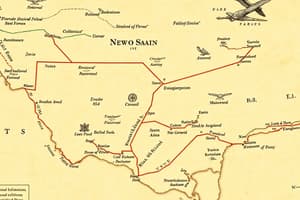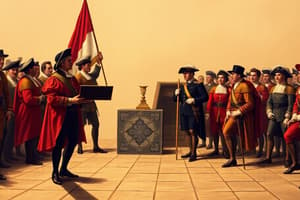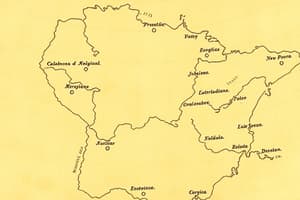Podcast
Questions and Answers
What was one of the primary objectives of the Bourbon Reforms in the political organization of New Spain?
What was one of the primary objectives of the Bourbon Reforms in the political organization of New Spain?
- Reintegrating traditional viceroys into the administration
- Reinstating the audience as the main governing body
- Establishing independent provincial governments
- Removing criollo influence from government positions (correct)
Which economic change was a direct result of the Bourbon Reforms?
Which economic change was a direct result of the Bourbon Reforms?
- A restriction on trade to only specific ports
- A decrease in tax revenues for the Crown
- An expansion of trade to allow all ports with colonies (correct)
- A centralization of wealth in criollo hands
What cultural impact did the Bourbons aim for with their reforms in New Spain?
What cultural impact did the Bourbons aim for with their reforms in New Spain?
- To revitalize local traditions in governance
- To enhance the power of the criollos
- To support indigenous autonomy
- To establish a Spanish bureaucratic system (correct)
What was a significant outcome of the Bourbon Reforms in New Spain concerning military presence?
What was a significant outcome of the Bourbon Reforms in New Spain concerning military presence?
How did the displacement of criollos from positions of power ultimately affect New Spain?
How did the displacement of criollos from positions of power ultimately affect New Spain?
What led to the decline of Spain's naval power on the Sevilla-Veracruz route by 1620?
What led to the decline of Spain's naval power on the Sevilla-Veracruz route by 1620?
Which event triggered the War of the Spanish Succession?
Which event triggered the War of the Spanish Succession?
What was one major goal of the Bourbon Reforms initiated by Charles III?
What was one major goal of the Bourbon Reforms initiated by Charles III?
Who was sent to New Spain to implement the Bourbon Reforms?
Who was sent to New Spain to implement the Bourbon Reforms?
How did the Bourbon Reforms affect the relationship between the Crown and local interests?
How did the Bourbon Reforms affect the relationship between the Crown and local interests?
What was one consequence of the trade ban with Peru in 1631?
What was one consequence of the trade ban with Peru in 1631?
Which of the following outcomes resulted from the Bourbon Reforms?
Which of the following outcomes resulted from the Bourbon Reforms?
What was the primary reason for the alliance formed against Spain during the War of the Spanish Succession?
What was the primary reason for the alliance formed against Spain during the War of the Spanish Succession?
What was one of the primary political goals of the Bourbon Reforms?
What was one of the primary political goals of the Bourbon Reforms?
How did the Bourbon Reforms impact the silver mining industry in New Spain?
How did the Bourbon Reforms impact the silver mining industry in New Spain?
What was one of the intended effects of reviving the imperial fleet system?
What was one of the intended effects of reviving the imperial fleet system?
In New Granada, how were the Bourbon Reforms perceived overall?
In New Granada, how were the Bourbon Reforms perceived overall?
What was one consequence of the irregular schedule of the fleet ships in New Granada?
What was one consequence of the irregular schedule of the fleet ships in New Granada?
Which approach did the Bourbon Reforms use to attempt to regain control over trade?
Which approach did the Bourbon Reforms use to attempt to regain control over trade?
Which of the following was a notable effect of the Bourbon Reforms in New Spain post-1750?
Which of the following was a notable effect of the Bourbon Reforms in New Spain post-1750?
What aspect of trade was disrupted due to the Bourbon Reforms in New Granada?
What aspect of trade was disrupted due to the Bourbon Reforms in New Granada?
Flashcards
Bourbon Reforms goal
Bourbon Reforms goal
To improve tax collection, political control, and economic management for Spain's benefit in its colonies.
Intendants
Intendants
Local officials who replaced previous officers to manage municipalities and improve tax collection within Spanish colonies.
Spanish Officials
Spanish Officials
Spanish university graduates filling administrative positions, replacing colonial elites (Criollos).
New Spain Army
New Spain Army
Signup and view all the flashcards
Increased Colonial Trade
Increased Colonial Trade
Signup and view all the flashcards
New Spain's Economic Decline
New Spain's Economic Decline
Signup and view all the flashcards
Bourbon Reforms in New Spain
Bourbon Reforms in New Spain
Signup and view all the flashcards
Bourbon Reforms in New Granada
Bourbon Reforms in New Granada
Signup and view all the flashcards
Regaining Trade Control
Regaining Trade Control
Signup and view all the flashcards
Imperial Fleet System
Imperial Fleet System
Signup and view all the flashcards
Unpredictable Fleet Schedules
Unpredictable Fleet Schedules
Signup and view all the flashcards
Spanish Naval Power
Spanish Naval Power
Signup and view all the flashcards
War of the Spanish Succession
War of the Spanish Succession
Signup and view all the flashcards
Philip V
Philip V
Signup and view all the flashcards
Bourbon Reforms
Bourbon Reforms
Signup and view all the flashcards
Charles III
Charles III
Signup and view all the flashcards
Jose de Galvez
Jose de Galvez
Signup and view all the flashcards
Centralization of Power
Centralization of Power
Signup and view all the flashcards
Reforms in New Spain
Reforms in New Spain
Signup and view all the flashcards
Study Notes
Introduction
- Habsburg dynasty ruled New Spain from 1521 to 1700.
- Bourbon dynasty, of French origin, took over after Charles II's death.
- A patrimonialist system developed under Habsburgs. Public offices bought, officials imposed taxes, monopolies developed, and corruption controlled the crown.
Bourbon Reforms
- King Charles III implemented Enlightenment-inspired policies to modernize Spain and its colonies (the "Bourbon Reforms").
- Reforms aimed at political-administrative, economic, military, and cultural modernization in the Americas.
- The goal was to regain control over American colonies, and make them more profitable for Spain.
- They aimed to assert the Crown's control over all aspects of the colonies, administrative, economic and political.
Latin America and the Bourbon Reforms
- Bourbon reforms aimed to revitalize Spain's declining Empire in the Americas.
- The reforms sought to increase royal control, end smuggling, and improve the taxation system.
- Modernize the transatlantic trade routes, which were often controlled by private traders.
- Increased the Spanish Empire's control over its territories, but also created opposition and discontent in colonies.
The Empire and Bourbon Reforms
- Spanish empire in the Americas had declined economically for decades before the Bourbon dynasty.
- Bourbon reforms aimed to make the empire profitable again.
- Key goals of reforms: end smuggling, control over transatlantic trade, modernize the tax system, and control over regional administration.
New Spain (Mexico)
- The century from 1640-1750 was a period of economic decline in New Spain.
- Bourbon attempts were made to revitalize the economy, especially through the silver mines, but reforms also had negative impacts.
New Granada
- Reforms in New Granada (modern-day Colombia, Venezuela, and Ecuador) were largely ineffective, and at times counterproductive.
- Attempts to improve trade and economic productivity failed in parts.
- The reform strategy of using a more regular system of imperial fleets caused chaos in trade instead.
Decline of Spanish Naval Power
-
Spain had a significant naval force in the 16th century
-
Trade routes were used to transport silver and goods to Europe and Asia.
-
Smuggling significantly damaged Spain's trade.
-
Loss of naval power and increased piracy negatively influenced Spain's trade.
-
The death of Charles II and succession struggle caused internal conflict and a decline.
The Reforms in New Spain
- Charles III (1759) initiated Bourbon Reforms.
- José de Galvez was sent to enforce reforms in New Spain.
- Goals of Bourbon reforms: strengthen monarchy, collect more revenue, control colonies more directly.
- Centralizing power (royal control over all aspects).
- Reorganize the bureaucracy with appointed officials instead of colonial aristocracy.
- Tax reforms to increase revenue. The reforms aimed for more efficient tax collection.
Studying That Suits You
Use AI to generate personalized quizzes and flashcards to suit your learning preferences.
Related Documents
Description
This quiz explores the transition from the Habsburg to Bourbon dynasties in New Spain, highlighting the significant reforms implemented by King Charles III. It examines the objectives and impacts of these Enlightenment-inspired strategies aimed at modernizing the Spanish Empire in the Americas. Test your understanding of this critical period in colonial history.




